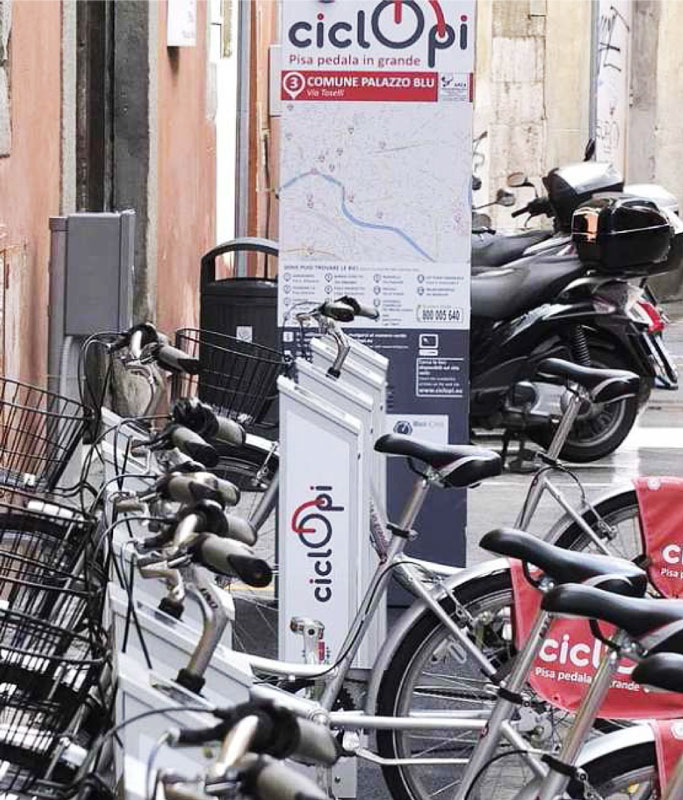by Davide Bacciu, Antonio Carta, Stefania Gnesi and Laura Semini, ISTI-CNR
We have applied a machine learning approach to both implement and assess new services for the users of a bike-sharing system. The aim is to predict the destination station of a bike in use, given information on its pick up details.
Bike-sharing systems (BSSs) are a means of smart transportation in urban environments with the benefit of a positive impact on urban mobility: the availability of a public bike, permitting point to point displacement can reduce the use of private cars in town.
The design of a BSS is multi-faceted and complex: a BSS has many components – including the human users as well as the bikes and stations. The users are an intrinsic part of any BSS, and their individual patterns of behaviour and specific preferences and needs have a decisive impact on the collective usability and performance of the system. Other issues that must be taken into consideration include the costs of installing, maintaining and running the BSS, and the particular characteristics of the city. Municipalities obviously wish to offer a successful and convenient service, so that people continue using it, reducing traffic congestion.

A CicloPi Bike Station in Pisa.
One of the main problems of a BSS is balancing the bicycles among the different stations. Some stations tend to fill up while others are empty, with these situations varying dynamically during the day. Studies have shown that user satisfaction can be improved by providing information on the status of the stations at run time. Most current systems supply this information in terms of number of bicycles parked in each docking station, through services available via the Internet. When the arrival station is full or the departure station empty, the user needs to know whether this situation is likely to change soon. A service is needed that can predict whether, at a given moment, there is high probability that someone will take a bike, making a place available in a full station, or that someone will return a bike to an empty station.
Machine Learning (ML) methodologies could be used to learn computational models of prediction features from BSS usage data [1]. Machine learning can be applied to realize data-driven adaptive approaches to predictive modelling of input-output data relationships. Through these methodologies, it is possible to learn the (unknown) relationship between a feature and its inputs by exploiting historical data providing examples of such an input-output map. A trained model can then be used to provide predictions on future values of the feature in response to new input information, i.e. providing an implementation of the feature component. This approach has two advantages. On the one hand, it provides a powerful and general means to realize a wide choice of predictive features for which there exist sufficient (and significant) historical data. On the other hand, trained ML models are provided with a measure of predictive performance that can be used as a metric to assess the cost-performance trade-off of the feature. This provides a principled way to assess the runtime behaviour of different components before putting them into operation.
We are using this machine learning approach to both implement and assess new predictive services for the users of a BSS. One example is LocationPreview, a service that predicts the destination station of a bike in circulation given information on its pick up details. This feature is implemented using one of the sub-features: StationProfile and UserProfile. These subfeatures are both based on training machine learning models, and are paradigmatic of a class of learning tasks dealing with static vectorial data. They differ in the data they use: the first is built on a feature that maintains the history (more than 280,000 entries) of all movements station-to-station with date and time, but user unaware (to train the models), the latter exploits user profiles by training personalized predictors.
Part of this research has been done in the context of the European FP7 project QUANTICOL [L1], on the quantitative analysis of smart transportation systems. In addition, we have begun collaboration with PisaMo S.p.A., an in-house public mobility company of the Municipality of Pisa, which introduced the BSS CicloPi in Pisa a few years ago.
Link:
[L1] http://www.quanticol.eu
Reference:
[1] D. Bacciu, S. Gnesi, L. Semini: “Using a Machine Learning Approach to Implement and Evaluate Product Line Features”, WWV 2015, El. Proc. in Theoretical Computer Science, vol. 188. EPTCS, 2015, p. 75-83.
Please contact:
Stefania Gnesi, ISTI-CNR, Italy











